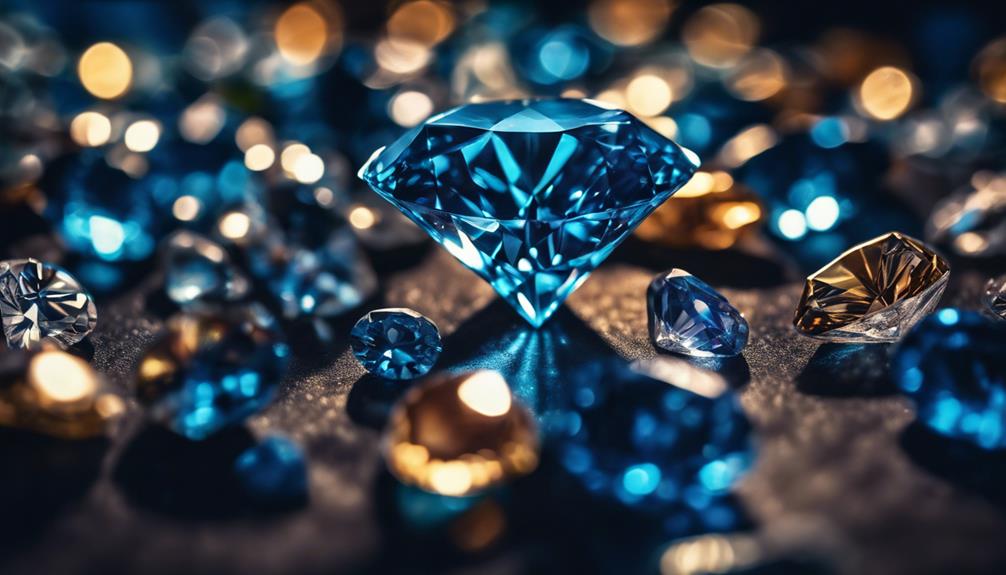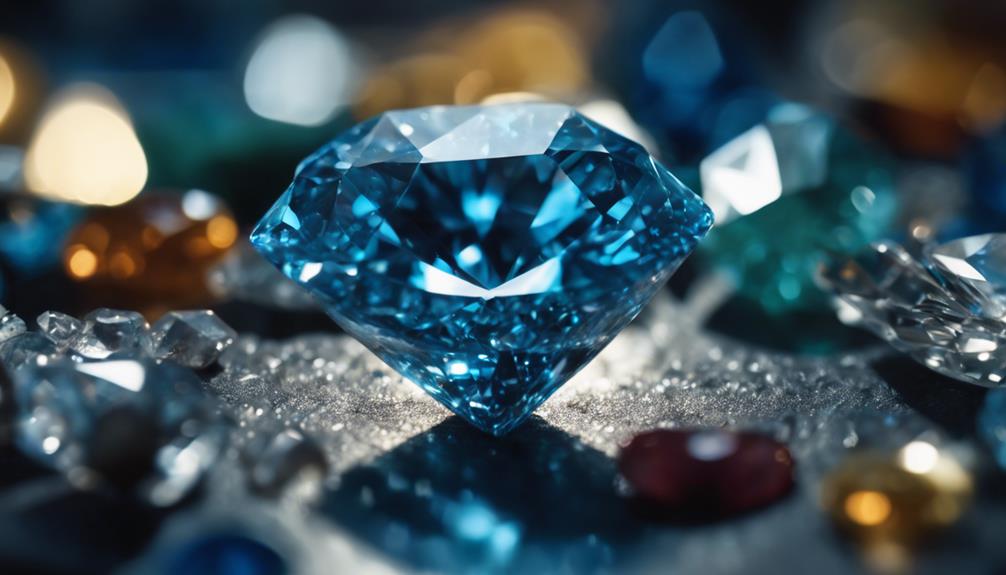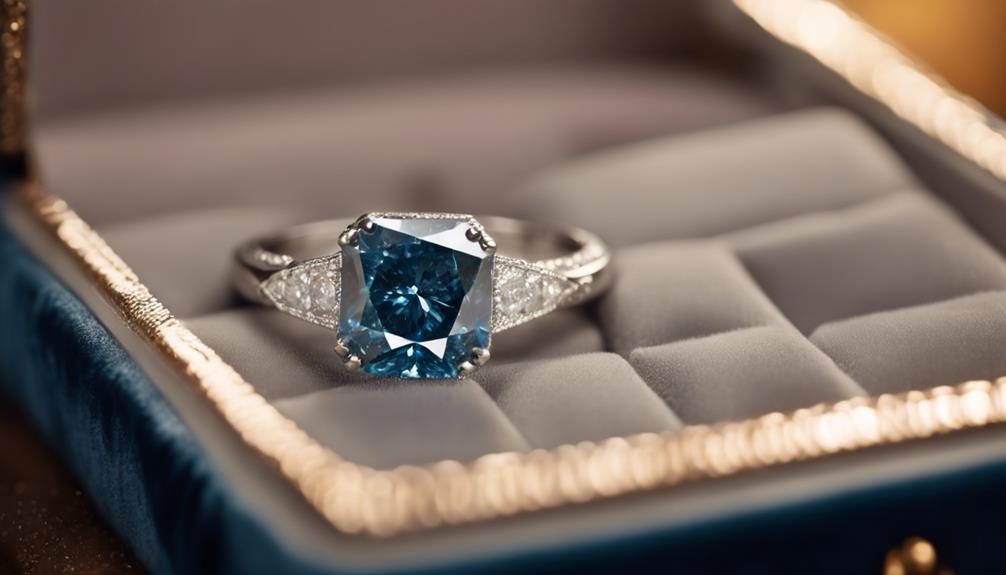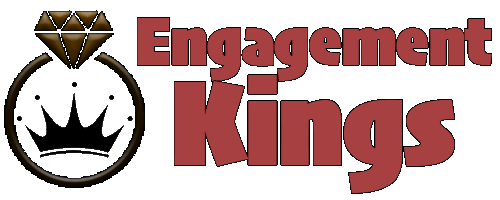When buying a natural blue diamond, focus on color intensity, rarity, and price. These gems get their stunning hue from boron, with deeper blues being the rarest. Top sources include South Africa, Australia, and India. Prices start around $26,280 for a light blue 0.5-carat diamond, but deep or vivid blues can soar past $410,500. Always purchase from reputable vendors and pay attention to the diamond’s 4Cs. Settings like halo or three-stone can accentuate the blue. For the best investment and quality, professional evaluation is vital. Discover more essential tips if you explore further.
Characteristics and Rarity

Blue diamonds, known for their stunning hues and extreme rarity, derive their enchanting color from trace amounts of boron within their carbon structure. This unique composition results in a spectrum of blue shades, from faint blue to fancy dark blue. Unlike treated or enhanced stones, blue diamonds are entirely natural, showcasing their true beauty without any artificial interventions.
You’ll find these rare gems primarily in three notable locations: Cullinan in South Africa, Argyle in Australia, and Golconda in India. These places have established themselves as the primary sources for these extraordinary diamonds. Among all colored diamonds, the Type IIb blue diamonds are the most exceptional, making up just 0.1% of the total. The deeper and more intense the blue, the rarer the diamond, which greatly increases its allure and desirability.
Due to their extreme scarcity, large blue diamonds often appear at auctions, drawing considerable attention from collectors and enthusiasts alike. Their unmatched rarity and natural beauty make blue diamonds highly sought after, not just as pieces of jewelry but as investments and symbols of prestige.
Pricing and Value
When considering the pricing and value of blue diamonds, it’s essential to understand that their rarity and color intensity greatly drive costs. Blue diamonds are some of the rarest gemstones, and their prices reflect this scarcity.
For instance, you’ll find that a 0.5-carat light blue diamond averages around $26,280. However, if you’re eyeing a deep or vivid blue diamond, a 0.25-carat stone can easily cost about $75,000.
As you explore larger carat weights and higher color intensities, prices skyrocket. A 0.76-carat fancy intense blue diamond, for example, is priced at approximately $410,500. Smaller blue diamonds, especially those below 0.3 carat, are relatively more affordable, but still command a premium due to their unique hue.
Given these variations, a professional evaluation is crucial when purchasing. The complexity of blue diamond pricing, influenced by the subtle differences in color and secondary hues, can make it challenging to determine true value.
Engaging with a knowledgeable jeweler guarantees you make an informed decision, maximizing your investment and securing a gem that meets your expectations in both beauty and quality.
Intensity and Combinations

Understanding the intensity levels and color combinations of blue diamonds is key to appreciating their unique beauty and value. Blue diamonds are graded on a scale ranging from Faint Blue to Fancy Vivid Blue. Here’s what you need to know:
- Intensity Levels: The color intensity of blue diamonds greatly impacts their value. Higher intensity levels, such as Fancy Intense Blue or Fancy Vivid Blue, are rarer and more valuable. These diamonds exhibit a richer, more saturated color.
- Secondary Hues: Blue diamonds often have secondary hues like gray or green. These can alter the diamond’s appearance and value. Pure blue diamonds, without any secondary hues, are exceptionally rare and highly prized.
- Unique Combinations: Unique color combinations can create stunning visual effects. For instance, a blue diamond with a slight greenish tint can appear more vibrant. The interplay of primary and secondary hues can enhance the overall aesthetic appeal.
Buying Recommendations
Given the rarity and unique characteristics of blue diamonds, it’s important to follow specific buying recommendations to guarantee you get the best value for your investment.
First, always buy from reputable vendors like Leibish & Co. or James Allen, which provide high-quality photos to ensure color accuracy. Check customer reviews to gauge their experiences and verify the vendor’s credibility.
Next, focus on the diamond’s 4Cs: cut, color, clarity, and carat weight. Blue diamonds with higher color intensity, such as Fancy Vivid Blue, are more valuable. However, secondary hues might reduce the price, so weigh your options based on your budget and preferences.
Professional evaluation is essential. Given the complexity of blue diamond pricing, an expert’s opinion can help you make an informed decision and avoid costly mistakes.
You might also consider personal buying advice from industry veterans to gain insight into market trends and price dynamics.
Jewelry and Settings

Have you thought about the stunning impact blue diamonds can have in various jewelry settings? These gems can transform any piece into a showstopper. Choosing the right setting can enhance their natural beauty and showcase their unique color.
Here are some popular options to think about:
- Halo Settings: This setting surrounds the blue diamond with smaller, colorless diamonds, magnifying its brilliance and making the central stone appear larger and more vibrant.
- Tension Settings: In this modern design, the blue diamond appears to float between the band, held in place by the tension of the metal. This setting isolates the diamond, drawing full attention to its striking hue.
- Three-Stone Settings: Flanking the blue diamond with two colorless diamonds creates a stunning contrast, highlighting the unique color of the blue diamond while adding overall brilliance to the piece.
Each setting offers a distinct way to highlight a blue diamond’s beauty. Whether you’re designing an engagement ring or a piece of statement jewelry, selecting the right setting can make all the difference.
Don’t forget to choose a reputable jeweler who can help you bring your vision to life.
Conclusion
You’ve now got the knowledge to make a confident decision when buying a natural blue diamond.
Remember to take into account color intensity, carat weight, and secondary hues to determine value.
Stick with reputable vendors to guarantee authenticity and quality.
Finally, choose a setting that highlights your gem’s unique beauty.
With these tips, you’re ready to invest in a blue diamond that not only dazzles but also stands the test of time.
Happy shopping!



